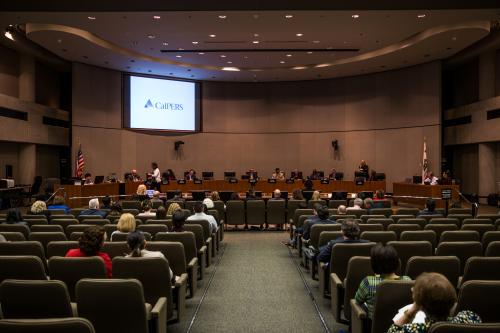A version of this paper was presented as part of the 6th annual Municipal Finance Conference, held July 17-18, 2017 at Brookings.
Though they often fly under the radar in public discourse, state and local pension plans are among the most important institutions in the modern economy. They provide retirement benefits for nearly 10 million beneficiaries; have nearly 20 million members, and manage nearly $4 trillion in assets.1 The huge scale of these plans means that seemingly obscure assumptions on investment returns and discount rates have enormous consequences.
In recent years, the risky funding system underlying these plans has come under fire in academic circles. For example, Brown and Wilcox (2009) and Rauh and Novy-Marx (2014) argue that the discount rates used by public plans to account for future liabilities are generally too high. These papers note that these liabilities, when discounted at rates closer to those offered by municipal bonds, are significantly larger and require substantially more upfront funding. Administrators of public plans have pushed back against this critique, arguing that commonly used discount rates better reflect the true historical experience and asset requirements facing plans (NASRA 2010).
While this discussion is an important one, it is academic in the sense that few major funds are currently invested in or are planning to invest in a portfolio concentrated in municipal bonds. State and local governments will not face a deterministic cost associated with a “riskless benchmark”, but rather a distribution of potential future costs determined by assumed discount rate, asset allocation, and other policy choices. It is crucial, then, that policy makers understand how their decisions interact with each other and affect the entire distribution of outcomes, rather than simply theoretical risk-free benchmarks or an assumed ‘average’ outcome.
Unfortunately, the current accounting guidelines for public pensions focus solely on assumed deterministic outcomes. The Government Accounting Standards Board (GASB) statements on accounting guidelines for defined benefit plans 2 do not even mention the word “distribution” in this context. We will show that this deterministic, assumption based approach can provide unreliable guidance to policy makers.
Another shortcoming with the existing debate is that models used by both academics and practitioners generally assume that state and local governments will indeed fund the promises they make. In practice, of course, governments often fail to come up with the money they “should” contribute according to their funding laws. In fact, a recent study found that less than 85% of the required payments to cover unfunded liabilities were made from 2001-2013.3 It is important to have a model that builds in this reality of pension funding, or non-funding, when trying to evaluate the costs of different policies.
In this paper, we aim to remedy this gap in the discussion. Building on models by Josh McGee and Michelle Welch (2014a, 2014b) we incorporate a realistic set of asset classes and return shocks into the model. We allow for plans to invest in a range of different asset classes, and simulate return processes that build in historical across-class correlations and non-normality. Using data on historical, within-class performance by public funds, we also estimate time-varying idiosyncratic variances within asset classes. The size of these idiosyncratic shocks vary with the cycle or average return, and together, create a rich and realistic distribution of asset market results. We then allow the model to dynamically account for these shocks, simulate return draws, and track how the system evolves over stochastic iterations. We calibrate the model to one large system, the Texas Employee Retirement System. By looking at the distribution of outcomes under different scenarios for this prototypical system, we can better shed light on the impact of policy choices and economic assumption on outcomes.
This exercise generates a few important insights. The first, and likely most important, is that the existing status quo is enormously risky. In our baseline simulation for the Texas ERS, under its current policies, the sum of the discounted amortized payments required over a 30-year period and final unfunded liabilities has a standard deviation of roughly 7.25% of the total present discounted value of payroll over that period. This means that the total cost to the taxpayers of Texas will vary significantly with states of the world going forward. The current system of pension accounting, whatever the discount rate used, doesn’t convey the risks inherent in the system and how policy choices affect those risks. In our conclusion, we discuss statistics that public plans could report using these types of simulations to make this risk transparent to policymakers.
Read the full paper here.
The author’s work on this article was funded in part by the Laura and John Arnold Foundation. With the exception of the aforementioned, the authors did not receive financial support from any firm or person with a financial or political interest in this article. Neither is currently an officer, director, or board member of any organization with an interest in this article.
-
Footnotes
- Annual Survey of Public Pensions: State- and Locally Administered Defined Benefit Data Summary Brief: 2015. https://www.census.gov/content/dam/Census/library/publications/2016/econ/g15-aspp-sl.pdf
- Available at: http://www.gasb.org/jsp/GASB/Page/GASBSectionPage&cid=1176163528472
- This calculation is on a weighted basis. http://www.nasra.org/files/JointPublications/NASRA_ARC_Spotlight.pdf
The Brookings Institution is committed to quality, independence, and impact.
We are supported by a diverse array of funders. In line with our values and policies, each Brookings publication represents the sole views of its author(s).








